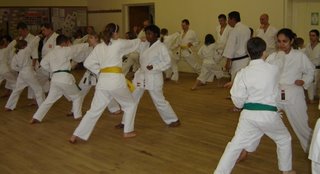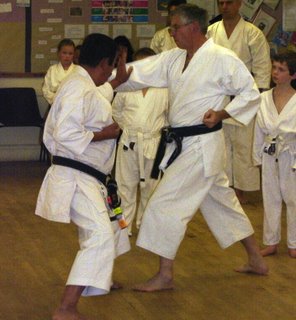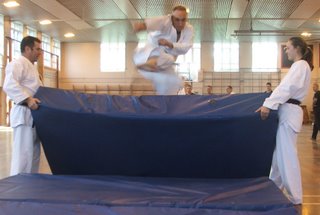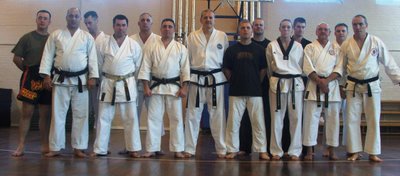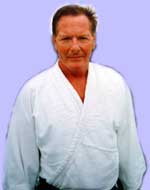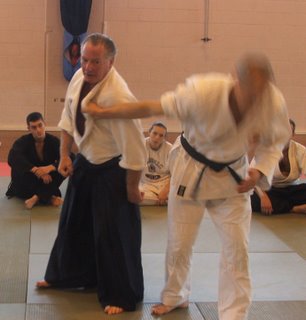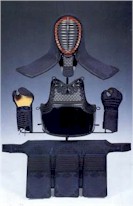Karate
I'm not going to say anything about the roots of Karate as a reader of this blog you are likely to be well informed, if you need any further background you can follow the links in the side bar to web sites that are far more informative than this one.
Sensei Wayne Otto OBE 5th Dan

Sensei Wayne Otto OBE is nine times World champion and fifteen times European champion. Sensei studies Uechi-ryu Karate more details can be found in the link section below.
The Italians have called him"Lo Squald Nero", the black shark and the French have called him "La Perle Noire", the black pearl.
All I know having the pleasure of being on the recieving end of a few techniques he is damn fast!
Sensei has also competed in the £10k cash events, details of his 2002 success also in the link section below.
Training
Sensei started with a warm up routine that the karte England squad use for kumite training, using five basic techniques:
Gyaku-Zuki, Kazame-Zuki, Mae-Geri,Mawashi-Geri, and Ushiro-Geri.
(Reverse Punch, Jab, Front snap kick, roundhouse kick and back kick)
1.To start with each technique was executed ten times.
2. Then all five techniques togeather were executed ten times.
3. Then with a partner the five attacks were used with the following defenses:
1st Attack - Gyaku-Zuki, Defence - Gedan Bari, Uraken Jodan (Downward sweeping block, backfist to the face)
2nd Attack - Kazamae-Zuki, Defence - Nagashi-uke, Gyaku-Zuki (Sweeping block, reverse punch)
3rd Attack - Mae-Geri, Defence - stepping in Gedan-bari, Gyaku-Zuki ( downward sweeping block, reverse punch)
4th Attack - Mawashi-Geri (off front foot stepping in), Defence - Teisho-uke, Gakyu-Zuki Jodan (palm heel block to kick spinning opponent and reverse punch to the back of the head)
5th Attack - Ushiro-Geri, Defense - Kazame Zuki Jodan (Jab to head as opponent turns head to start to spin)
4. Then about six or seven of us lined up facing an opponent, each person in turn executed first 1 technnique , then 2 ..3..4...5 techniques, the person at the front carrying out the defenses, then the person at the front changed places and the exercise was repeated for every person in the line. As you can imagine everyone was exhausted by the end of this first warm up exercise, good training though, when each person in the line is doing five attacks at speed you really start working hard with your defences or you get more than a few knocks.

Left: Col Dave Hopwood looks on as Sensei Otto explains the virtues of Mikazuki-geri (crescent kick), Sensei brought the kick further to the side than I have usually bring the technique, then would bring it across using the power of the leg muscles with devestating effect.
I found the technique particularly effective when brought into the solar plexus, Sensei kindly picked me up off the floor, and told me to stop making him look bad, he might not get invited back.
It was a pleasure to be "dropped" by a world champion, Osu!
The back foot was brought to the front foot and then the Mikazuki-geri was executed from the front foot, the foot was brought high and then cut down. It was very quick to close the distance and was an awkward kick to defend against. The kicks were tried in both right and left stance.
Following on from this the defender would tighten his guard to protect his mid section, again Mikazuki but brought down on the lead hand of the guard, followed by a Gyaku-zuki chudan. The technique was practiced in both stances.
The third technique built up in the series was Mikazuki-geri, Gyakui-zuki followed by Mawashi-geri jodan, round house kick to the head. The attacker adopting a line just to the outside of the defender in a low posture to enable them to open their hips to kick to the head.
Sensei also added a sweep into the technique, the Mikazuki-geri would be high and sharp but as a fient followed by gyaku-zuki, this would be blocked Gedann-bari by the defender, the attacker placing their front foot behind the defenders front foot and Ashi-bari (foot sweep).

Left: Sensei Otto square up to WO2 Dunnell
Sensei demonstrated a mean Ushiro-mawashi-geri on the Sergeant Major, which landed with the heel just behind the right ear. A definite "Ippon" technique, I don't know how he managed to stay on his feet, most of us would have had more than a wobble on.
Sensei Otto also did a take down technique, both attacker and defender are in the same stance. You grab your opponents front wrist with your front hand, rotating around the opponent your right arm goes high across their chest in a low Kiba-dachi (horse ridding) stance. You stand up into Shizen-tai (Natural position) spreading your arms out with the shoulders back. As the defender falls to the floor you complete the technique with a Gyaku-zuiki or geri (kick).

Left : WO2 Dunnell and SSgt Mo Morris
The attack Kazamae-zuki, defended Nageshi-uke, Gyaku-zuki
Sensei Otto's course was very much Kumite (Sparring) based, starting with sparring drills and then going on to practice techniques that had worked for him in competition. One of the main differences I noted was the extensive use of the front foot to kick with rather than the rear. It is obviously slower to bring the foot from the rear. Sensei closes the distance to the opponent with the half step that also creates momentum for the front foot technique. Again a lot to think about in the days course.

The Karate Course Photo
A very good day was had by all, I am sure I am not in any way biased when I say that.
Thank you Sensei- Osu!
Links
Uechi-ryu KarateKarate England10K 2002 reportVideo
I would have liked to have found a good quality video of one of my instructors Asai or Kato Shihan undergoing combat, but unfortunately I dont have any, so below is a karate demo instead.
karate demoThis is post four in a series of six on the AMA Course.
If you have jumped into the middle of our blog via a search engine you may want to go to our latest post; please follow the link below that will relaunch the blog
SSKC latest post
 Above: Another great course and grading session for Haxby, York and Selby karate clubs.
Above: Another great course and grading session for Haxby, York and Selby karate clubs. Above: Dave has to dig deep on his physical and mental reserves during his grading, Sensei Nick is always happy to put anyone through their paces.
Above: Dave has to dig deep on his physical and mental reserves during his grading, Sensei Nick is always happy to put anyone through their paces.
